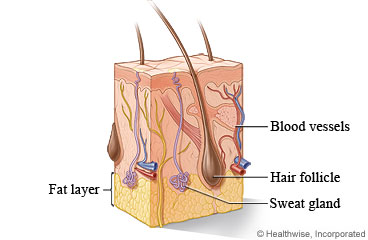Folliculitis: Care Instructions

Overview
Folliculitis (say "fuh-LIK-yuh-LY-tus") is an inflammation of the hair follicles. Each hair on your body grows out of a tiny pouch called a follicle. You can have folliculitis on any part of your body that has hair.
Folliculitis is usually caused by bacteria. It also can be caused by other things, such as an ingrown hair. You can also get folliculitis if you have damaged hair follicles. Shaving or wearing clothes that rub the skin can irritate the follicles. This makes them more likely to become infected.
Symptoms include pimple-like bumps. They may be reddish and have pus in them. The bumps can be tender and may itch or burn. Sometimes the condition can lead to more serious skin infections.
Treatment depends on what's causing it. A mild case will usually go away on its own. If it doesn't, your doctor can treat it with an antibiotic cream or ointment. Antibiotics you take as pills can treat infections deeper in the skin. If the condition is caused by ingrown hairs from shaving, you could try not shaving or change how you are shaving.
Follow-up care is a key part of your treatment and safety. Be sure to make and go to all appointments, and call your doctor or nurse advice line (811 in most provinces and territories) if you are having problems. It's also a good idea to know your test results and keep a list of the medicines you take.
How can you care for yourself at home?
- To help with itching or pain, put a warm, moist cloth (like a clean face cloth) on the area for 5 to 10 minutes, 3 to 6 times a day.
- Do not share your towel, face cloth, or razor.
- If the condition is caused by shaving, try to avoid shaving the area for a few weeks. Or use shaving cream or gel and always shave in the direction that the hair grows. Try using an electric razor that doesn't shave so close.
- Wear loose clothing, especially if it's hot or humid outside. Change your clothes if they get sweaty.
- Take your medicine exactly as prescribed. If your doctor prescribed antibiotics, take them as directed. Do not stop taking them just because you feel better. You need to take the full course of antibiotics.
When should you call for help?
Call your doctor or nurse advice line now or seek immediate medical care if:
- You have signs that your infection is getting worse, such as:
- Increased pain, swelling, warmth, or redness.
- Red streaks leading from the area.
- Pus draining from the area.
- A fever.
Watch closely for changes in your health, and be sure to contact your doctor or nurse advice line if:
- You do not get better as expected.
Where can you learn more?
Go to https://www.healthwise.net/patientEd
Enter M257 in the search box to learn more about "Folliculitis: Care Instructions".
Current as of: December 4, 2024
